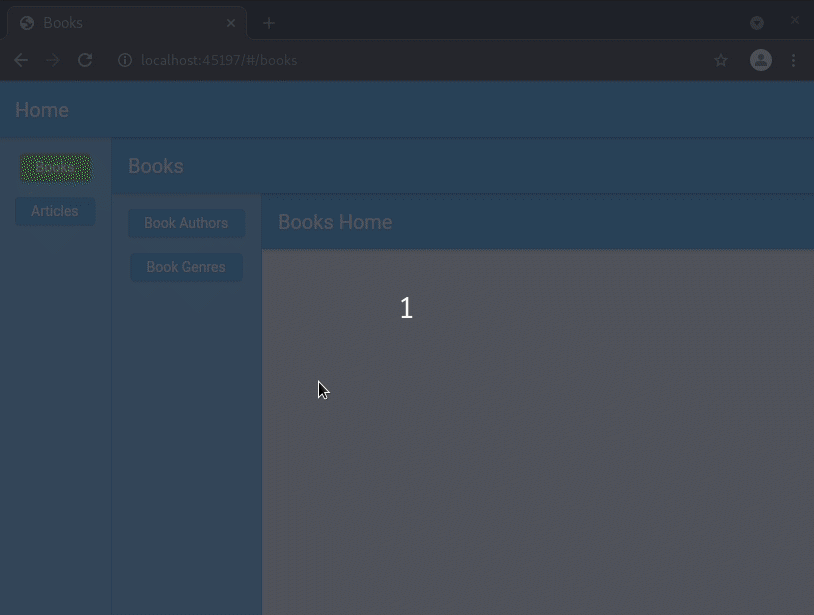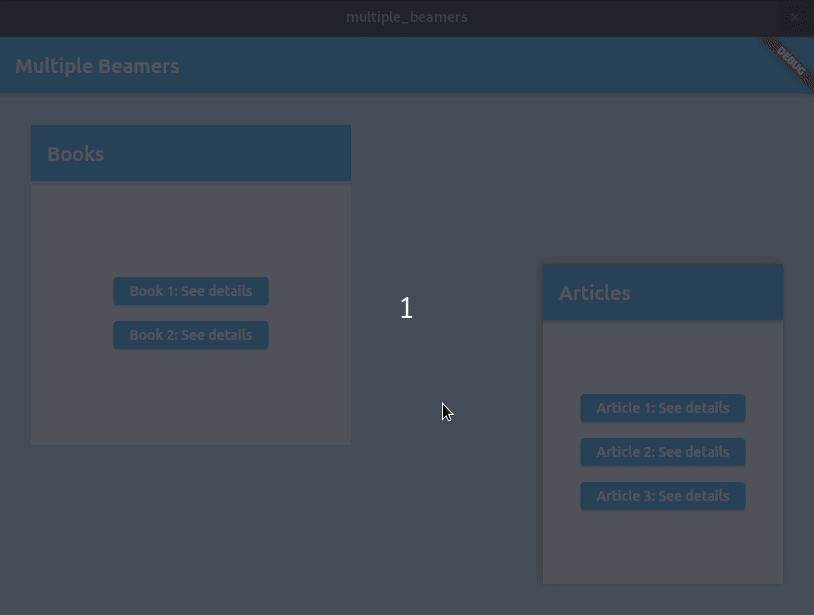
Beamer uses the power of Router and implements all the underlying logic for you, letting you explore arbitrarily complex navigation scenarios with ease.



Quick Start
For most navigation scenarios, using the RoutesLocationBuilder is a great choice which yields the least amount of code. After setting up our App like this, we can start navigating with Beamer.of(context).beamToNamed('/books/2').
class MyApp extends StatelessWidget {
final routerDelegate = BeamerDelegate(
locationBuilder: RoutesLocationBuilder(
routes: {
// Return either Widgets or BeamPages if more customization is needed
'/': (context, state, data) => HomeScreen(),
'/books': (context, state, data) => BooksScreen(),
'/books/:bookId': (context, state, data) {
// Take the path parameter of interest from BeamState
final bookId = state.pathParameters['bookId']!;
// Collect arbitrary data that persists throughout navigation
final info = (data as MyObject).info;
// Use BeamPage to define custom behavior
return BeamPage(
key: ValueKey('book-$bookId'),
title: 'A Book #$bookId',
popToNamed: '/',
type: BeamPageType.scaleTransition,
child: BookDetailsScreen(bookId, info),
);
}
},
),
);
@override
Widget build(BuildContext context) {
return MaterialApp.router(
routeInformationParser: BeamerParser(),
routerDelegate: routerDelegate,
);
}
}
RoutesLocationBuilder will pick and sort routes based on their paths.
For example;
- navigating to
/books/1will match all 3 entries fromroutesand stack them on top of each other - navigating to
/bookswill match the first 2 entries fromroutes
The corresponding pages are put into Navigator.pages and BeamerDelegate (re)builds the Navigator, showing the selected stack of pages on the screen.
Why do we have a locationBuilder and what is a BeamLocation, the output of it?
BeamLocation is an entity which, based on its state, decides what pages should go into Navigator.pages. locationBuilder chooses the appropriate BeamLocation that should further handle the incoming RouteInformation. This is most commonly achieved by examining BeamLocation.pathPatterns.
RoutesLocationBuilder returns a special type of BeamLocation - RoutesBeamLocation, that has opinionated implementation for most common navigation use-cases. If RoutesLocationBuilder doesn't provide desired behavior or enough customization, one can extend BeamLocation to define and organize the behavior for any number of page stacks that can go into Navigator.pages.
Further reading: BeamLocation, BeamState.
Navigating
Navigation is done by "beaming". One can think of it as teleporting (beaming) to another place in your app. Similar to Navigator.of(context).pushReplacementNamed('/my-route'), but Beamer is not limited to a single page, nor to a push per se. BeamLocations produce a stack of pages that get built when you beam there. Beaming can feel like using many of Navigator's push/pop methods at once.
// Basic beaming
Beamer.of(context).beamToNamed('/books/2');
// Beaming with an extension method on BuildContext
context.beamToNamed('/books/2');
// Beaming with additional data that persist
// throughout navigation within the same BeamLocation
context.beamToNamed('/book/2', data: MyObject());
Navigating Back
There are 2 types of going back, i.e. reverse navigation; upward and reverse chronological.
Upward (popping a page from stack)
Upward navigation is navigating to a previous page in the current page stack. This is better known as "pop" and is done through Navigator's pop/maybePop methods. The default AppBar's BackButton will call this if nothing else is specified.
Navigator.of(context).maybePop();
Reverse Chronological (beaming to previous state)
Reverse chronological navigation is navigating to wherever we were before. In case of deep-linking (e.g. coming to /books/2 from /authors/3 instead of from /books), this will not be the same as pop. Beamer keeps navigation history in beamingHistory so there is an ability to navigate chronologically to a previous entry in beamingHistory. This is called "beaming back". Reverse chronological navigation is also what the browser's back button does, although not via beamBack, but through its internal mechanics.
Beamer.of(context).beamBack();
Android back button
Integration of Android's back button with beaming is achieved by setting a backButtonDispatcher in MaterialApp.router. This dispatcher needs a reference to the same BeamerDelegate that is set for routerDelegate.
MaterialApp.router(
...
routerDelegate: beamerDelegate,
backButtonDispatcher: BeamerBackButtonDispatcher(delegate: beamerDelegate),
)
BeamerBackButtonDispatcher will try to pop first and fallback to beamBack if pop is not possible. If beamBack returns false (there is nowhere to beam back to), Android's back button will close the app, possibly opening a previously used app that was responsible for opening this app via deep-link. BeamerBackButtonDispatcher can be configured to alwaysBeamBack (meaning it won't attempt pop) or to not fallbackToBeamBack (meaning it won't attempt beamBack).
Accessing nearest Beamer
Accessing route attributes in Widgets (for example, bookId for building BookDetailsScreen) can be done with
@override
Widget build(BuildContext context) {
final beamState = Beamer.of(context).currentBeamLocation.state as BeamState;
final bookId = beamState.pathParameters['bookId'];
...
}
Using "Navigator 1.0"
Note that "Navigator 1.0" (i.e. imperative push/pop and friends) can be used alongside Beamer. We already saw that Navigator.pop is used for upward navigation. This tells us that we are using the same Navigator, but just with a different API.
Pages pushed with Navigator.of(context).push (or any similar action) will not be contributing to BeamLocation's state, meaning the browser's URL will not change. One can update just the URL via Beamer.of(context).updateRouteInformation(...). Of course, when using Beamer on mobile, this is a non-issue as there is no URL to be seen.
In general, every navigation scenario should be implementable declaratively (defining page stacks) instead of imperatively (pushing), but the difficulty to do so may vary.
Resources
Here's a list of some useful articles and videos about Beamer:
- An easy package to use Flutter Navigator 2 | Pair program with the author of the Beamer! (YouTube video from Majid's Flutter Original Series)
- Beamer v1.0.0 (Medium article)
- "Navigator 2.0" and Beamer (Slides from Flutter ZG Meetup)
- Explaining Flutter Nav 2.0 and Beamer (Medium article by Toby Lewis)
- Router; Problems and Solutions (slides from Flutter Festival London talk)
Key Concepts
At the highest level, Beamer is a wrapper for Router and uses its own implementations for RouterDelegate and RouteInformationParser. The goal of Beamer is to separate the responsibility of building a page stack for Navigator.pages into multiple classes with different states, instead of one global state for all page stacks.
For example, we would like to handle all the profile related page stacks such as
[ ProfilePage ],[ ProfilePage, FriendsPage],[ ProfilePage, FriendsPage, FriendDetailsPage ],[ ProfilePage, SettingsPage ],- ...
with some "ProfileHandler" that knows which "state" corresponds to which page stack. Then similarly, we would like to have a "ShopHandler" for all the possible stacks of shop related pages such as
[ ShopPage ],[ ShopPage, CategoriesPage ],[ ShopPage, CategoriesPage, ItemsPage ],[ ShopPage, CategoriesPage, ItemsPage, ItemDetailsPage ],[ ShopPage, ItemsPage, ItemDetailsPage ],[ ShopPage, CartPage ],- ...
These "Handlers" are called BeamLocations.
BeamLocations cannot work by themselves. When the RouteInformation comes into the app via deep-link, as initial or as a result of beaming, there must be a decision which BeamLocation will further handle this RouteInformation and build pages for the Navigator. This is the job of BeamerDelegate.locationBuilder that will take the RouteInformation and give it to appropriate BeamLocation based on pathPatterns it supports. BeamLocation will then create and save its own state from it to use for building a page stack.

BeamLocation
The most important construct in Beamer is a BeamLocation which represents a state of a stack of one or more pages.
BeamLocation has 3 important roles:
- know which URIs it can handle:
pathPatterns - know how to build a stack of pages:
buildPages - keep a
statethat provides a link between the first 2
BeamLocation is an abstract class which needs to be extended. The purpose of having multiple BeamLocations is to architecturally separate unrelated "places" in an application. For example, BooksLocation can handle all the pages related to books and ArticlesLocation everything related to articles.
This is an example of a BeamLocation:
class BooksLocation extends BeamLocation<BeamState> {
@override
List<Pattern> get pathPatterns => ['/books/:bookId'];
@override
List<BeamPage> buildPages(BuildContext context, BeamState state) {
final pages = [
const BeamPage(
key: ValueKey('home'),
child: HomeScreen(),
),
if (state.uri.pathSegments.contains('books'))
const BeamPage(
key: ValueKey('books'),
child: BooksScreen(),
),
];
final String? bookIdParameter = state.pathParameters['bookId'];
if (bookIdParameter != null) {
final bookId = int.tryParse(bookIdParameter);
pages.add(
BeamPage(
key: ValueKey('book-$bookIdParameter'),
title: 'Book #$bookIdParameter',
child: BookDetailsScreen(bookId: bookId),
),
);
}
return pages;
}
}
BeamState
BeamState is a pre-made state that can be used for custom BeamLocations. It keeps various URI attributes such as pathPatternSegments (the segments of chosen path pattern, as each BeamLocation supports many of those), pathParameters and queryParameters.
Custom State
Any class can be used as state for a BeamLocation, e.g. ChangeNotifier. The only requirement is that a state for BeamLocation mixes with RouteInformationSerializable that will enforce the implementation of fromRouteInformation and toRouteInformation.
Full example app can be seen here.
When using a custom MyState that can notify its BeamLocation when it updates, we can also navigate like this
onTap: () {
final state = context.currentBeamLocation.state as MyState;
state.selectedBookId = 3;
},
Note that Beamer.of(context).beamToNamed('/books/3') would produce the same result.
Usage
To use Beamer (or any Router), one must construct the *App widget with .router constructor (read more at Router documentation).
Along with all the regular *App attributes, we must also provide
routeInformationParserthat parses an incoming URI.routerDelegatethat controls (re)building ofNavigator
Here we use Beamer's implementation of those - BeamerParser and BeamerDelegate, to which we pass the desired LocationBuilder. In the simplest form, LocationBuilder is just a function which takes the current RouteInformation and returns a BeamLocation based on the URI or other state properties. The returned BeamLocation will then provide a list of pages for the Navigator.
class MyApp extends StatelessWidget {
final routerDelegate = BeamerDelegate(
locationBuilder: (routeInformation, _) {
if (routeInformation.location!.contains('books')) {
return BooksLocation(routeInformation);
}
return HomeLocation(routeInformation);
},
);
@override
Widget build(BuildContext context) {
return MaterialApp.router(
routerDelegate: routerDelegate,
routeInformationParser: BeamerParser(),
backButtonDispatcher:
BeamerBackButtonDispatcher(delegate: routerDelegate),
);
}
}
There are two other options available, if we don't want to define a custom locationBuilder ourselves.
With a List of BeamLocations
BeamerLocationBuilder can be used with a list of BeamLocations. This builder will automatically select the correct BeamLocation based on its pathPatterns or return a NotFound if none matches.
final routerDelegate = BeamerDelegate(
locationBuilder: BeamerLocationBuilder(
beamLocations: [
HomeLocation(),
BooksLocation(),
],
),
);
With a Map of Routes
We can use the RoutesLocationBuilder with a map of routes, as mentioned in Quick Start. This completely removes the need for custom BeamLocations, but also gives the least amount of customization. Still, wildcards and path parameters are supported as with all the other options.
final routerDelegate = BeamerDelegate(
locationBuilder: RoutesLocationBuilder(
routes: {
'/': (context, state, data) => HomeScreen(),
'/books': (context, state, data) => BooksScreen(),
'/books/:bookId': (context, state, data) =>
BookDetailsScreen(
bookId: state.pathParameters['bookId'],
),
},
),
);
Nested Navigation
When nested navigation (i.e. nested Navigator) is needed, one can just put Beamer anywhere in the Widget tree where this nested navigation will take place. There is no limit on how many Beamers an app can have. Common use case is a bottom navigation, where the BottomNavigationBar should not be affected by navigation transitions, i.e. all the navigation is happening above it, inside another Beamer. In the snippet below, we also use a key on Beamer so that a BottomNavigationBar can manipulate just the navigation within that Beamer. We have a lot of examples for nested navigation:
- Bottom Navigation
- Bottom Navigation 2
- Bottom Navigation with multiple Beamers
- Nested Navigation drawers
- Sibling Beamers
There are some special attributes of BeamerDelegate that are used only when there are multiple Beamers in the tree. Their function is quite complicated so we try to have sensible defaults (all true) that work well for most use cases;
initializeFromParent: This is used to initialize theBeamLocationof childBeamerDelegatewhen itsBeamergets built in the Widget tree. It istrueby default, meaning that theBeamerDelegatewill create itsBeamLocationfrom theconfigurationof the parentBeamerDelegate. Iffalse, theBeamerDelegatewill use itsinitialPathfor initialization, regardless of what is the currentconfigurationon parent.updateFromParent: Similar toinitializeFromParent, but this, iftrue(default), sets up a listener that callsBeamerDelegate.updatewith parent'sconfigurationwhenever the parent updates, regardless of whether this caused a rebuild of its (child's)Beamer.updateParent: This is used for updating the other way around, for the childBeamerDelegateto update its parentBeamerDelegate. Most notably, it keeps thebeamingHistoryof both in sync. This is important forBeamerBackButtonDispatcherwhich is connected to just the rootBeamerDelegateand may want to executebeamBack(). Also, the Widget tree will get built as it were when we do a global rebuild.
class HomeScreen extends StatelessWidget {
HomeScreen({Key? key}) : super(key: key);
final _beamerKey = GlobalKey<BeamerState>();
final _routerDelegate = BeamerDelegate(
locationBuilder: BeamerLocationBuilder(
beamLocations: [
BooksLocation(),
ArticlesLocation(),
],
),
);
@override
Widget build(BuildContext context) {
return Scaffold(
body: Beamer(
key: _beamerKey,
routerDelegate: _routerDelegate,
),
bottomNavigationBar: BottomNavigationBarWidget(
beamerKey: _beamerKey,
),
);
}
}
class MyApp extends StatelessWidget {
final routerDelegate = BeamerDelegate(
initialPath: '/books',
locationBuilder: RoutesLocationBuilder(
routes: {
'*': (context, state, data) => HomeScreen(),
},
),
);
@override
Widget build(BuildContext context) {
return MaterialApp.router(
routerDelegate: routerDelegate,
routeInformationParser: BeamerParser(),
);
}
}
Guards
To guard specific routes, e.g. from un-authenticated users, global BeamGuards can be set up via BeamerDelegate.guards property. A most common example would be the BeamGuard that guards any route that is not /login and redirects to /login if the user is not authenticated:
BeamGuard(
// on which path patterns (from incoming routes) to perform the check
pathPatterns: ['/login'],
// perform the check on all patterns that **don't** have a match in pathPatterns
guardNonMatching: true,
// return false to redirect
check: (context, location) => context.isUserAuthenticated(),
// where to redirect on a false check
beamToNamed: (origin, target) => '/login',
)
Note the usage of guardNonMatching in this example. This is important because guards (there can be many of them, each guarding different aspects) will run in recursion on the output of previously applied guard until a "safe" route is reached. A common mistake is to setup a guard with pathBlueprints: ['*'] to guard everything, but everything also includes /login (which should be a "safe" route) and this leads to an infinite loop:
- check
/login - user not authenticated
- beam to
/login - check
/login - user not authenticated
- beam to
/login - ...
Of course, guardNonMatching needs not to be used. Sometimes we wish to guard just a few routes that can be specified explicitly. Here is an example of a guard that has the same role as above, implemented with guardNonMatching: false (default):
BeamGuard(
pathBlueprints: ['/profile/*', '/orders/*'],
check: (context, location) => context.isUserAuthenticated(),
beamToNamed: (origin, target) => '/login',
)
General Notes
-
When extending
BeamLocation, two methods need to be implemented:pathPatternsandbuildPages.buildPagesreturns a stack of pages that will be built byNavigatorwhen you beam there, andpathPatternsis there for Beamer to decide whichBeamLocationhandles which URI.BeamLocationkeeps query and path parameters from URI in itsBeamState. The:is necessary inpathPatternsif you might get path parameter from browser.
-
BeamPage's child is an arbitraryWidgetthat represents your app screen / page.
Page Keys
When we beam somewhere, we are putting a new list of pages into Navigator.pages. Now the Navigator has to decide on the transition between the old list of pages and the new list of pages.
In order to know which pages changed and which pages stayed the same, Navigator looks at the pages' keys. If the keys of 2 pages that are compared are equal (important here: null == null), Navigator treats them as the same page and does not rebuild nor replace that page.
One should always set a BeamPage.key (most likely a ValueKey).
If keys are not set, after beaming somewhere via e.g. Beamer.of(context).beamToNamed('/somewhere'), no change will happen in the UI. The new BeamPage doesn't build since Navigator thinks it is the same as the already displayed one.
Tips and Common Issues
- Removing the
#from URL can be done by callingBeamer.setPathUrlStrategy()beforerunApp(). - Using
beamToReplacement*will replace the current entry inbeamingHistoryand browser history. BeamPage.titleis used for setting the browser tab title by default and can be opt-out by settingBeamerDelegate.setBrowserTabTitletofalse.- Losing state on hot reload
Examples
Check out all examples (with gifs) here.
-
Location Builders: a recreation of the example app from this article where you can learn a lot about Navigator 2.0. This example showcases all 3 options of using
locationBuilder. -
Advanced Books: for a step further, we add more flows to demonstrate the power of Beamer.
-
Deep Location: you can instantly beam to a location in your app that has many pages stacked (deep linking) and then pop them one by one or simply
beamBackto where you came from. Note thatbeamBackOnPopparameter ofbeamToNamedmight be useful here to overrideAppBar'spopwithbeamBack. -
Provider: you can override
BeamLocation.builderto provide some data to the entire location, i.e. to all thepages. -
Guards: you can define global guards (for example, authentication guard) or
BeamLocation.guardsthat keep a specific stack safe. -
Authentication Bloc: an example on how to use
BeamGuards for an authentication flow with flutter_bloc for state management. -
Bottom Navigation: an examples of putting
Beamerinto the Widget tree when using a bottom navigation bar. -
Bottom Navigation 2: the same as above, but with routes for details pushed on top of everything.
-
Bottom Navigation With Multiple Beamers: having
Beamerin each tab. -
Nested Navigation: nested navigation drawer
-
Multiple Beamers: multiple sibling Beamers working independently side by side.
NOTE: In all nested Beamers, full paths must be specified when defining BeamLocations and beaming.
- Animated Rail: example with animated_rail package.
Migrating
From 0.14 to 1.X
An article explaning changes and providing a migration guide is available here at Medium. Most notable breaking changes:
- If using a
SimpleLocationBuilder:
Instead of
locationBuilder: SimpleLocationBuilder(
routes: {
'/': (context, state) => MyWidget(),
'/another': (context, state) => AnotherThatNeedsState(state)
}
)
now we have
locationBuilder: RoutesLocationBuilder(
routes: {
'/': (context, state, data) => MyWidget(),
'/another': (context, state, data) => AnotherThatNeedsState(state)
}
)
- If using a custom
BeamLocation:
Instead of
class BooksLocation extends BeamLocation {
@override
List<Pattern> get pathBlueprints => ['/books/:bookId'];
...
}
now we have
class BooksLocation extends BeamLocation<BeamState> {
@override
List<Pattern> get pathPatterns => ['/books/:bookId'];
...
}
From 0.13 to 0.14
Instead of
locationBuilder: SimpleLocationBuilder(
routes: {
'/': (context) => MyWidget(),
'/another': (context) {
final state = context.currentBeamLocation.state;
return AnotherThatNeedsState(state);
}
}
)
now we have
locationBuilder: SimpleLocationBuilder(
routes: {
'/': (context, state) => MyWidget(),
'/another': (context, state) => AnotherThatNeedsState(state)
}
)
From 0.12 to 0.13
- rename
BeamerRouterDelegatetoBeamerDelegate - rename
BeamerRouteInformationParsertoBeamerParser - rename
pagesBuildertobuildPages - rename
Beamer.of(context).currentLocationtoBeamer.of(context).currentBeamLocation
From 0.11 to 0.12
- There's no
RootRouterDelegateanymore. Just rename it toBeamerDelegate. If you were using itshomeBuilder, useSimpleLocationBuilderand thenroutes: {'/': (context) => HomeScreen()}. - Behavior of
beamBackwas changed to go to previousBeamState, notBeamLocation. If this is not what you want, usepopBeamLocation()that has the same behavior as oldbeamback.
From 0.10 to 0.11
BeamerDelegate.beamLocationsis nowlocationBuilder. SeeBeamerLocationBuilderfor easiest migration.Beamernow takesBeamerDelegate, notBeamLocationsdirectlybuildPagesnow also bringsstate
From 0.9 to 0.10
BeamLocationconstructor now takes onlyBeamState state. (there's no need to define special constructors and callsuperif you usebeamToNamed)- most of the attributes that were in
BeamLocationare now inBeamLocation.state. When accessing them throughBeamLocation:pathParametersis nowstate.pathParametersqueryParametersis nowstate.queryParametersdatais nowstate.datapathSegmentsis nowstate.pathBlueprintSegmentsuriis nowstate.uri
From 0.7 to 0.8
- rename
pagestobuildPagesinBeamLocations - pass
beamLocationstoBeamerDelegateinstead ofBeamerParser. See Usage
From 0.4 to 0.5
- instead of wrapping
MaterialAppwithBeamer, use*App.router() String BeamLocation.pathBlueprintis nowList<String> BeamLocation.pathBlueprintsBeamLocation.withParametersconstructor is removed and all parameters are handled with 1 constructor. See example if you needsuper.BeamPage.pageis now calledBeamPage.child
Help and Chat
For any problems, questions, suggestions, fun,... join us at Discord
Contributing
If you notice any bugs not present in issues, please file a new issue. If you are willing to fix or enhance things yourself, you are very welcome to make a pull request. Before making a pull request:
- if you wish to solve an existing issue, please let us know in issue comments first.
- if you have another enhancement in mind, create an issue for it first, so we can discuss your idea.
See you at our list of awesome contributors!
- devj3ns
- ggirotto
- matuella
- youssefali424
- schultek
- hatem-u
- jmysliv
- jeduden
- omacranger
- samdogg7
- Goddchen
- spicybackend
- cedvdb
- Shiba-Kar
- gabriel-mocioaca
- AdamBuchweitz
- nikitadol
- ened
- luketg8
- Zambrella
- piyushchauhan
- marcguilera
- mat100payette
- Lorenzohidalgo
- timshadel
- definev
- britannio
- satyajitghana
- jpangburn










